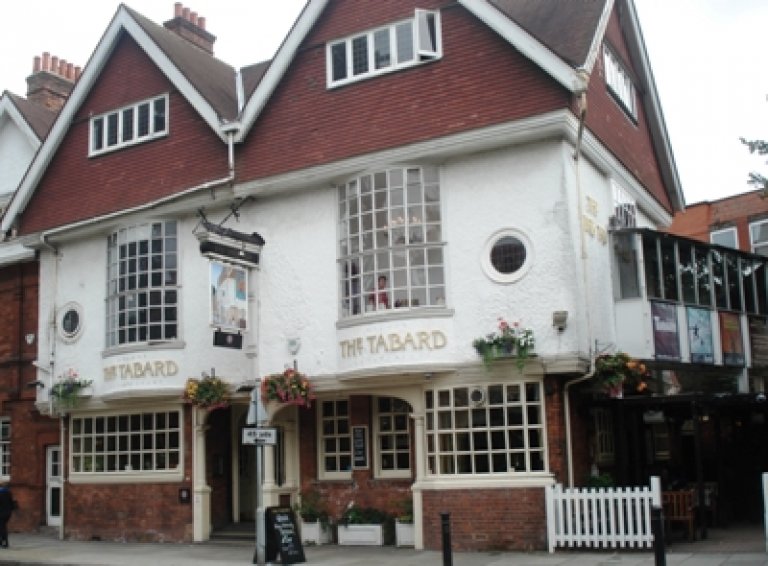Tabard
2 Bath RoadTurnham Green
W4 1LW
Not only is this pub a grade II* listed building, it is also a Two Star pub on CAMRA’s National Inventory as a pub with an interior of very special national historic interest, and the description is as follows: “The Tabard dates back to 1880 and was a pioneering 'improved' pub built as part of the Bedford Park estate, the first London garden suburb. The pub was designed by architect Richard Norman Shaw and is Grade II*-listed. The exterior swing sign (with a different image on each side) is a replica of the original which was painted by Thomas Matthews Rooke (1842-1942), who was at one time a studio assistant in Chiswick to Sir Edward Burne-Jones. Inside, particularly on the right, there is colourful Arts and Crafts tiling that covers the upper parts of the wall, which features snakes and blue birds by William De Morgan. In the left-hand bar on the overmantel look for the pair of two-tile panels depicting nursery rhyme scenes, hand-painted in blue enamel on plain Dutch tin-glazed tiles which have descriptions 'Where are you going my pretty maid’ and 'The maid was in the garden’. Also, above another fireplace is another two-part tiled painting, damaged, with the description 'Little Bo-Peep fell fast asleep’. These were most probably designed by Walter Crane and decorated in the Morris & Co. workshops.This pub retains two separate bars, although it also possible to move between them by two corridors, one behind the servery, and the other immediately in front of the bar counter. The bar back is from a 1971 refurbishment, but the counter looks original with a replacement top – note the ‘cupboards’ in the counter frontage to allow access to the beer engines. The panelling is mostly modern. The pub has been extended to the left into a neighbouring house to create more drinking spaces. On the first floor is the Tabard Theatre, an intimate 79-seat fringe theatre which has been host to the likes of Al Murray, Harry Hill and Russell Brand.”
The listing description is as follows: “A row formerly comprising a public house, private house and stores, now a public house and offices. 1880 by Richard Norman Shaw, as part of Jonathan Carr's development of Bedford Park. Red brick with rough-cast, tile-hanging, tiled roofs. A three storey row, divided into seven gabled bays, recessed in the centre. The Tabard: the western two bays comprise the Tabard, with gabled return to the west. Ground floor with entrance porch carried on Tuscan columns, flanked by many-paned windows. First floor with projecting bow windows flanked by round windows; projecting painted pub sign suspended from a moulded beam. Projecting twin-gabled overhang to upper floor above moulded cornice: tile-hung, with five light mullioned windows in each gable. Similar return to the west, partly hidden by a later fire escape. Tile-hung rear extension. Central two bays: Brick-faced up to second floor level. Pair of six-pane doors within gauged brick shouldered surrounds with pediments; four 416 pane sash windows to ground floor with keystones and aprons. First floor has four 616 pane sash windows with hoods, keystones and aprons, set between Doric pilasters supporting an entablature; upper storey is jet tied and rough-cast. The easternmost three bays were originally used as stores, now offices. Extensively glazed ground floors, over lunettes to basement; three eight-light leaded oriel 'Ipswich' windows on brackets to first floor; seven-light windows with arched centres to jet tied second floor. Return to Flanders Road of similar treatment, with large garage door to ground floor; rear elevation with oriel windows to first floor. INTERIORS: interior of Tabard includes numerous items of note. These include: entrance lobbies with glazed doors and overdoor strapwork reliefs; painted tile decoration by William de Morgan to walls; moulded dado rails, door and window surrounds; panelled bar counter with metal foot rest; alcove with console-framed arch; bolection-moulded chimneypieces with nursery rhyme tiles and mirror; panelled rear alcove. Extension to left incorporates former ground floor of neighbouring house: two adjoining rooms with tongue and groove panelling up to dado rail; skylight to rear. First floor: currently in use as theatre, reached via stairs with panelling up to dado rail. Features include large chimney piece with moulded surround incorporating painted tiles with egg and dart moulding; fielded panelling up to dado rail; two panel doors; window seat. Interiors of No.2 Bath Road modernised as offices; upper floors not inspected.
HISTORY: These buildings, together with St Michael's Church, were designed as the social centre-piece of Bedford Park and proved highly influential for subsequent suburban developments. Inspired by Staples Inn in Holborn, these buildings are in Shaw's English Domestic Revival (or 'Queen Anne') style and were to be widely imitated in Britain and the United States of America. The Tabard was a pioneering 'improved' pub and represented a rejection of the Gin Palace in favour of a more traditionally inspired and respectable inn. REFERENCES: Building News, 2nd Jan and 31st Jan. 1880; Andrew Saint, Richard Norman Shaw (1976),209; Mark Girouard, Sweetness and Light (1984),202.”
The Tabard featured on the Daytime Crawl of Chiswick and Brentford on 19 February 2005, the Style, Substance and E Numbers: Daytime Crawl of Greenford, West Ealing, Acton and Chiswick on 28 February 2009, and the Never Mind the Bollo..., We're the London Pubs Group: Daytime Pub Tour of Brentford, Acton Green and Turnham Green on 14 October 2023.
The WhatPub link is here: WhatPub/Tabard
The Pub Heritage Group link is here: PHG/Tabard



